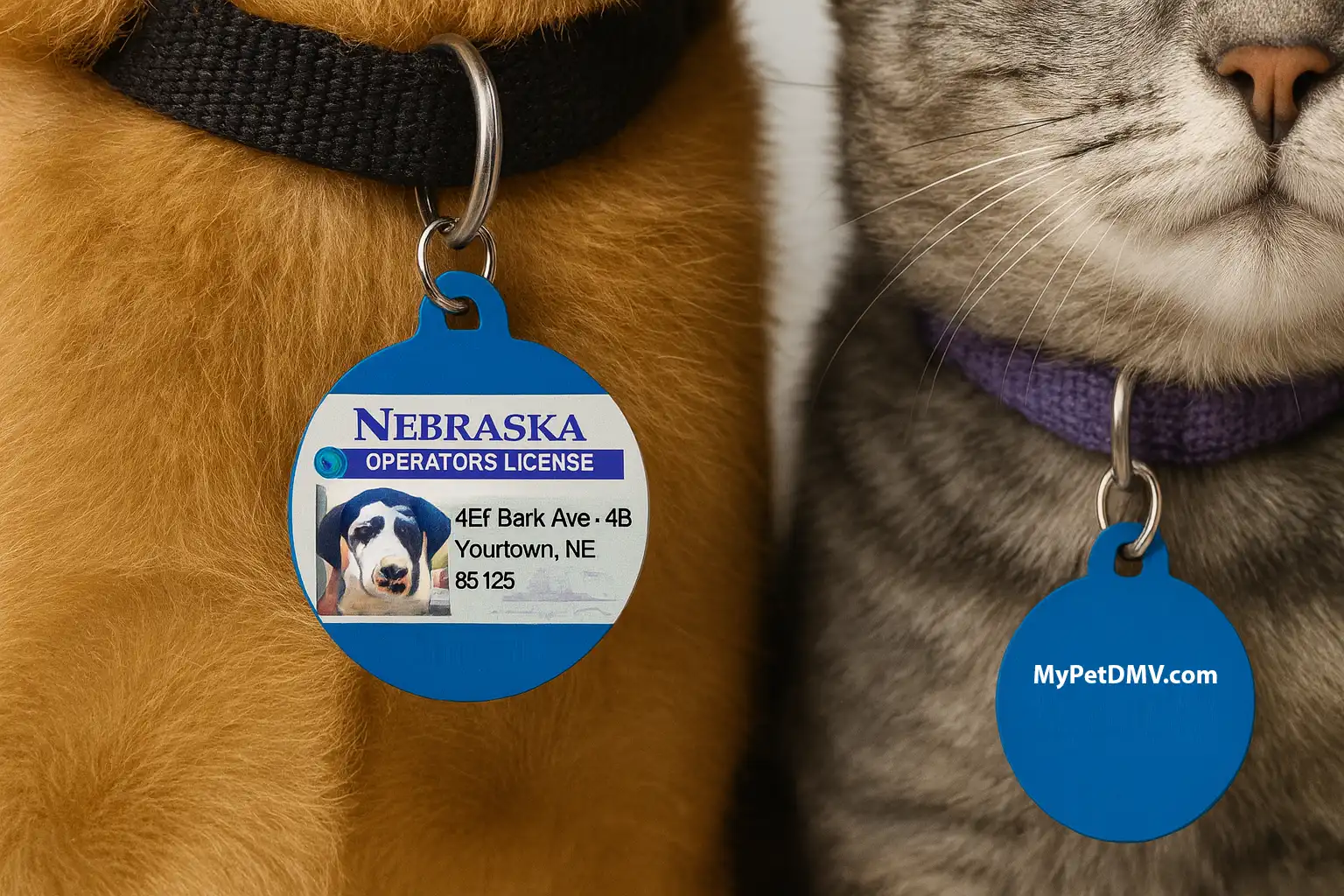Every pet owner hopes their furry friend never goes missing, but the reality is that pet ID tags are a crucial safeguard. Whether you opt for simple dog ID tags or fun personalized pet ID tags with unique designs, having identification on your pet can mean the difference between a quick reunion and a heartbreaking loss. Sadly, many people underestimate how important this little tag can be – according to surveys, only about one-third of pet owners always keep ID tags on their pets. In this post, we’ll explore 5 powerful reasons why every pet needs a pet ID tag for their safety and your peace of mind.
What Is a Pet ID Tag?
A pet ID tag (sometimes called a dog identification tag for canines or a cat ID tag for felines) is a small tag attached to your pet’s collar or harness that displays your pet’s identifying information. At minimum, it usually shows the pet’s name and your phone number. Many custom pet ID tags also include an address, email, or even a QR code. Animal shelters and rescue organizations strongly recommend using pet identification tags for dogs and cats to show that an animal has an owner and isn’t a stray. In fact, in some places it’s required by law – for example, UK regulations state that “every dog while in a public place shall wear a collar with the name and address of the owner” on an ID tag. The goal is simple: if someone finds your lost pet, they can immediately see how to contact you and help get your beloved companion home.
It’s important to note that a pet ID tag is the most visible form of pet identification. A microchip (a tiny implant under the pet’s skin linked to your details in a database) is another valuable ID tool, but it requires a special scanner at a vet or shelter. An average person who finds your dog or cat can’t read a microchip on the spot. A tag, on the other hand, can be read by anyone at a glance. In the sections below, we’ll break down why pet ID tags are so important and how they protect your dog, cat, or other pet.

1. Immediate Identification & Safe Return if Lost
No matter how careful you are, there’s always a chance your pet could get lost. A door might accidentally be left open, a loud noise like fireworks could scare your dog into bolting, or an indoor cat could slip out unnoticed. It happens more often than you’d think. In fact, statistics show that 1 in 3 pets will go missing at some point in their one-year, and without any ID, the majority may never find their way home. Roughly 10 million pets are lost every year in the United States alone. Those numbers are sobering – only about 15% of dogs and an alarming 2% of cats without ID tags or microchips are ever reunited with their owners.
Having identification on your pet dramatically improves the odds of a happy reunion. If someone finds your wandering pup or kitty, your contact information is right there on the tag, so they can call you immediately. Whether it’s a dog ID tag or a cat ID tag, the finder will instantly know this animal has a family looking for them. Compare that to a pet with no identification – people who encounter a tagless animal might assume it’s a stray with no home and be less inclined to intervene. With a tag and collar, it’s clear your pet isn’t homeless, and whoever finds them can quickly reach you to arrange a safe return. Time is of the essence when a pet goes missing, and a visible ID tag is the fastest way to get that phone call with good news.
2. Preparedness for Unexpected Situations
Life is unpredictable, and disasters or accidents can happen anytime. Natural disasters like hurricanes, wildfires, or earthquakes could force you to evacuate suddenly. Everyday emergencies happen too – for example, a car accident or a house fire could separate you from your pet, or a contractor might leave a gate open by mistake. In chaotic moments, even a well-trained dog or an indoor cat can become disoriented and lost. Even pets that normally stay indoors are not 100% safe from the unexpected; a frightened indoor cat could dash out during commotion, or you might need to temporarily relocate and the pet could slip away in unfamiliar surroundings.
The best way to protect your furry family member is to prepare ahead of time. Making sure your dog or cat is always wearing a collar with an ID tag is a simple but effective step in disaster preparedness. Think of it as your pet’s ticket home in any crisis. If your pet gets lost during a storm or emergency, that little tag becomes their voice when they can’t speak. It tells whoever finds your animal exactly how to reach you. In a widespread emergency situation, cell service or power might be disrupted, so it’s wise to include multiple contact methods (for example, your cell, a partner’s number, and maybe a backup relative’s number or email) on the tag. The bottom line is that unexpected events happen to everyone – but if your pet is wearing an ID tag, you’ve given them a lifeline to get back to you as soon as possible.
3. Strangers Are More Likely to Help a Pet with ID
Imagine you come across a dog or cat wandering alone in your neighborhood. If you notice it has a collar and an ID tag, you immediately know this pet is lost and needs help getting home. Most animal lovers will approach a pet with tags, check the pet identification tag for contact info, and try to reunite the animal with its owner. A tag is like a sign that says, “I have an owner – please help me get back to them!” Good Samaritans are generally much more willing to stop and assist a stray that clearly belongs to a family.
On the other hand, if someone encounters a pet with no ID at all, they might hesitate to get involved. An unknown dog without tags could be mistaken for a stray or even a feral animal, which some people fear might carry disease or not be friendly. This hesitation is especially true for cats – unfortunately, people often assume an outdoor cat without a collar or tag has no owner (a community stray) and might not make any effort to find its family. In some cases, a finder might even keep the pet or take it to a shelter, believing it was abandoned. You don’t want that to happen to your beloved companion. By outfitting your pet with a visible ID tag (there are pet identification tags for dogs and cats of all sizes), you make it immediately obvious that this animal has an owner. That greatly increases the chances that whoever finds your pet will call you right away instead of ignoring the animal or handing it over to a crowded shelter.
Additionally, a pet wearing tags may be handled more gently and given better care by whoever finds them. The tag signals that the pet is likely vaccinated and well-cared for, so people tend to be more comfortable helping. In contrast, animals without any identification are more likely to end up in municipal shelters where outcomes can be uncertain. For example, lost cats without ID are rarely reclaimed – often only a few percent are ever reunited with owners in time. Simply having a tag on your pet helps keep them out of shelters and in your arms where they belong.
4. Complements Microchips as a First Line of Defense
Some pet owners wonder, “My pet is microchipped – do they really need an ID tag as well?” The answer is absolutely yes! Microchips and ID tags work together to maximize your pet’s protection, and one should never replace the other. While a microchip is a permanent form of identification and an important backup, it’s not visible to the naked eye. If someone finds your dog or cat, they won’t know a chip is there or have the equipment to read it immediately. They would have to take the pet to a veterinary clinic or shelter to scan for a chip, which takes time and relies on that person going out of their way to get it done.
An ID tag, however, provides instant information — no special tools required. Anyone who finds your pet can read the tag and contact you on the spot. It’s often said that pet ID tags are the fastest way to get your pet home in a rescue scenario. Even animal shelter staff will look for an external tag first when a lost pet is brought in, because it lets them call the owner right away and potentially avoid admitting the animal to the shelter at all. Only if there’s no tag will they move on to scanning for a microchip – and not all shelters have the same scanners, plus microchips can sometimes be missed. You can’t assume everyone who finds a pet will think to check for a microchip. That’s why an old-fashioned external tag is so critical as the first line of defense, with the microchip serving as a safety net if the tag is lost or unreadable. For maximum safety, it’s best to use both a tag and a microchip, but never skip the external ID tag because that’s usually what brings your pet home fastest.
5. Affordable, Customizable, and No Reason to Delay
One more reason there’s really no excuse to go without a pet ID tag: it’s incredibly easy and inexpensive to get one, and you can personalize it however you like. Basic engraved pet ID tags (typically metal or durable plastic) are very affordable – often just a few dollars at a pet store kiosk or online. It only takes a few minutes to have one engraved with your pet’s name and your contact info. Think of it as a tiny investment for a huge return in peace of mind. In a way, an ID tag is like very cheap insurance for your pet’s safety.
Beyond the low cost and effort required, today’s personalized pet ID tags offer tons of options to fit your needs and your pet’s style. You’re not limited to the classic plain metal bone or circle (although those work perfectly well!). Pet owners can choose unique pet ID tags that reflect their pet’s personality or provide extra functionality. For example, there are ID tags shaped like bones, fish, hearts, or even miniature driver’s licenses and name badges. Some companies make pet tags that look like small ID cards with your pet’s photo and address on them, allowing you to include more info than a tiny tag would normally hold. You can also get tags in a variety of materials and with handy features: stainless steel or aluminum tags that are laser-engraved (so the text won’t wear off), durable plastic tags that are light and quiet, even waterproof pet ID tags or glow-in-the-dark tags for adventurous pets. There are also tags with modern tech like QR codes or NFC chips that allow someone to scan the tag with a smartphone for your contact and vet info.
In short, you can easily find a custom pet ID tag to perfectly suit your pet. Whether you want something fun and flashy or simple and rugged for an active outdoor dog, there’s an option out there. The most important thing is that it clearly displays your up-to-date contact information. Given how easy and cheap it is to get a quality ID tag (even the best pet ID tags usually cost only a little more), there’s truly no reason to put it off. It’s one of the simplest, most effective ways to protect your pet.
Overall, a pet ID tag is one of the simplest yet most important tools for keeping your dog or cat safe. It greatly increases the chances that a lost pet will be reunited with you quickly, even in unpredictable situations. It signals to others that your pet is loved and not a stray, encouraging people to help rather than ignore the animal. And it complements microchipping by providing immediate, visible identification. Considering how affordable and customizable tags are nowadays, making sure your pet wears an ID tag at all times is a no-brainer. Don’t wait for a scare or close call – get your pet a proper ID tag today and have them wear it whenever they go out (and ideally even at home, since you never know when they might slip out). It’s a small step that can make a life-saving difference for your furry family member.
Frequently Asked Questions
Q: Why are pet ID tags important?
A: Pet ID tags are important because they dramatically improve the chances of a lost pet returning home. They provide instant identification and contact info to anyone who finds your animal, which can be lifesaving. Without a tag (or microchip), a lost pet is much less likely to be reunited with its owner – only a tiny percentage of unidentified pets ever make it back. An ID tag is the fastest, easiest way for someone to get in touch with you if they find your dog or cat.
Q: Do I need an ID tag for my dog if he’s microchipped?
A: Yes, absolutely. A microchip alone isn’t enough because it’s not visible to the average person. If your dog goes missing, a dog identification tag on his collar lets anyone who finds him call you right away – no special scanner or vet visit needed. Microchips are a fantastic backup (and you should definitely microchip your pets), but they only help if someone brings the animal to a facility with a microchip scanner. The ID tag is your pet’s first line of defense and significantly increases the odds of a quick reunion.
Q: Should indoor cats wear ID tags?
A: Yes. Cat ID tags are recommended for all cats, even those that live strictly indoors. Cats are quick and curious, and an indoor cat can sometimes slip outside through an open door or window unexpectedly. If that happens, your cat will be in an unfamiliar area and may not know how to get home. A collar and ID tag are your cat’s best chance of being helped by a neighbor or animal control officer and returned to you. Without a tag, someone who finds your cat might assume it doesn’t have an owner and not make any effort to return it. For safety, use a breakaway collar for your cat (a collar that will safely snap open if it gets caught on something) and attach an ID tag to it at all times.
Q: What information should I put on a pet identification tag?
A: At the very least, put your primary phone number – the one you’re most likely to answer if a stranger calls. Most people also include the pet’s name (so whoever finds them can address the pet calmly) and a secondary phone number (such as a spouse or a close friend, in case you miss the call). If there’s room, you can add your last name or a partial address (for example, city and state). Many engraved tags allow text on both sides, so you could use the back for extra info like “Microchipped” or any urgent medical needs (e.g. “Needs Medication”). The key is to make sure someone can reach you easily and quickly if they have your pet.
Q: How do I choose the best pet ID tag for my pet?
A: The best ID tag is one that fits your pet’s size and lifestyle, and is durable enough to stay readable. For dogs, especially large or active dogs, choose a tag made of sturdy material like stainless steel or thick plastic, and make sure it’s securely attached (using a strong split ring or even a rivet-on style). If your dog spends a lot of time outdoors, consider waterproof pet ID tags or tags with protective coatings so the engraving won’t wear down due to rain, mud, or rough play. For cats, select a lightweight tag that’s small enough for a cat to wear comfortably, and attach it to a breakaway collar for safety. Both dogs and cats benefit from tags with clear, easy-to-read text (avoid overly fancy fonts that are hard to decipher). You can get creative with shapes and colors – the unique pet ID tags out there are fun – just ensure the tag remains legible. Ultimately, the best tag is one your pet can wear 24/7 without irritation and that clearly displays your up-to-date contact information.




